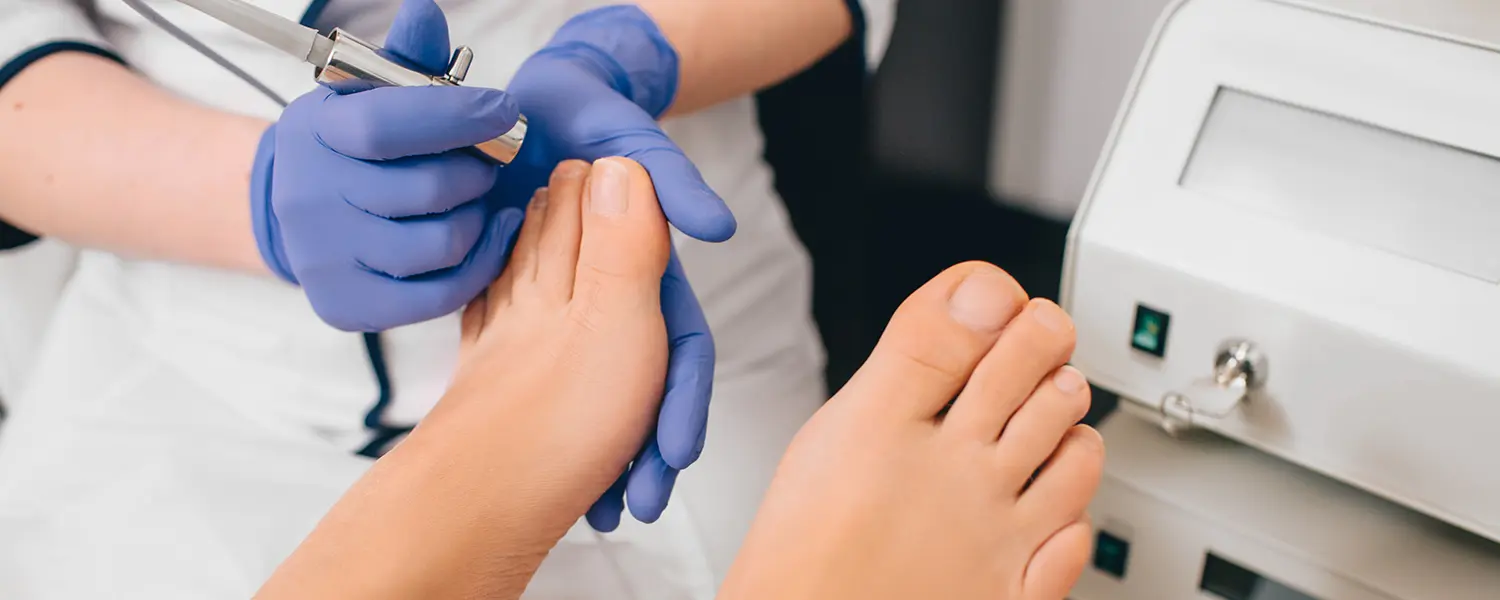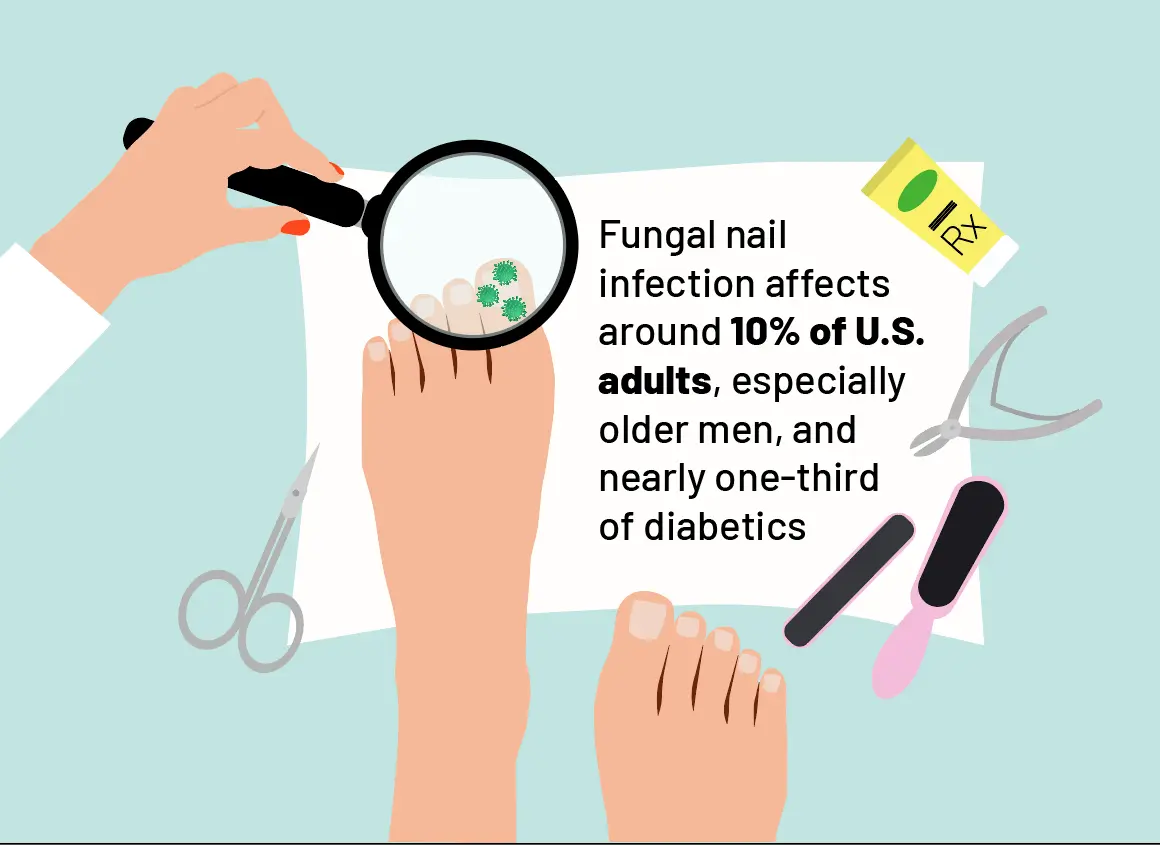Nail Care for Feet: The Essential Guide to Healthy Toenails

Taking care of your toenails goes far beyond beauty—it’s a critical component of overall foot health.
Whether you’re running marathons or simply navigating daily life, proper nail care for your feet prevents pain, infections, and long-term complications. Neglecting toenails can escalate into serious health concerns, burdening individuals and the healthcare system. Often having one’s nail issues seen by a podiatric physician may alert one to disease states they were not even aware of.
Poor Nail Care Impact in the U.S.
Fungal Nail Infection – Onychomycosis
- Onychomycosis affects around 10% of U.S. adults, especially older men, and nearly one-third of diabetics.1
- Besides thickened, discolored nails, Onychomycosis can lead to cellulitis (redness with possible infection) or skin infections, particularly in those with poor circulation.
Ingrown Toenails – Onychocryptosis
- Ingrown toenails are one of the most common foot conditions which is about 20% of primary care foot issues.2
- Improper trimming (curving edges), tight shoes, obesity, trauma, and diabetes frequently can cause ingrown toenails.3
Nail Trauma – Subungual Hematomas
- Injuries such as dropping a heavy object can cause bleeding under the nail, leading to pain, nail loss, or infection. To manage the nail trauma, podiatrists will relieve pressure or remove damaged tissue. There may be underlying fractures hidden that a podiatric physician can diagnose and treat.
These 3 issues often coexist. Fungal infections can worsen ingrown nails, and injuries may pave the way for infections without proper nail care.
Three Common Issues from Poor Nail Care
1. Ingrown Toenails
When toenails are not trimmed correctly, especially around the corners of the toe, they can grow into the skin causing swelling, pain, and bacterial or fungal infections. Left untreated, ingrown nails can lead to ulcers or osteomyelitis (bone infection), especially in people with diabetes.

2. Fungal Nail Infections
Thick, brittle, yellowing nails are often signs of onychomycosis. These infections are stubborn, frequently recur, and may lead to cellulitis when the skin barrier is compromised.
3. Nail Trauma & Hematomas
Foot injuries result in subungual hematomas which are painful blood pools under the nail. When left unchecked, they may need to be drained or removed to prevent more issues.
Ways to Care for Your Toenails at Home:
Trim Toenails Properly
- Cut straight across to avoid curved edges which invite ingrown nails.
- Keep nails just above the toe tip—too short fosters ingrowth.
- If you are diabetic or have any circulatory issues, you should see a podiatric physician to determine if professional care for your nails is critical.
Keep Feet Clean & Dry
- Wash your feet daily and dry thoroughly (especially between toes) to reduce fungal growth.
- Change your socks daily and choose breathable fabrics.
Sanitize Tools & Avoid Trauma
- Use dedicated, sterilized clippers and files to avoid spreading fungi or bacteria.
- If you encounter an injury, monitor it for discoloration or pain; seek podiatric care for hematomas or bleeding.
Why You Should See a Podiatrists to Manage Your Nail Issues
Seeing a professional for foot nail care ensures accurate diagnosis, effective treatment, and long-term protection. Podiatrists can distinguish between fungal, bacterial, traumatic, or systemic issues—an essential step for proper treatment. With this clarity, they offer medical-grade procedures tailored to your specific condition, whether it’s an infection, a structural problem, or a result of injury. Beyond treatment, they provide expert guidance on maintaining foot health over time.
Perhaps most importantly, professional care offers peace of mind and helps prevent small problems from turning into major complications. This is especially critical for individuals with diabetes or weakened immune systems, where even minor nail issues can quickly lead to deep infections or systemic illness.
Professional podiatrists (DPMs) specialize in diagnosing and treating complex nail problems:
Diagnosis
- Podiatrists use visual clinical examinations and lab tests (e.g., fungal cultures) distinguish onychomycosis from other causes.
- Foot scans assess vascular, neurological, and structural factors like bunions, hammertoes, or diabetic neuropathy.
Treatment Approaches
- Ingrown nails: Our podiatrists use conservative methods like lifting the nail, wedge resection, or full removal under local anesthesia in-office.
- Fungal infections: Some situations require debridement, prescription topical/oral antifungals (e.g., terbinafine), and even laser therapy. Our doctors confirm each diagnosis before starting any treatments.
- Hematomas/trauma: If necessary, the toenail can be drained via a small puncture or surgical removal to prevent infection.
Preventive & Risk-Based Care
- We recommend regular check‑ups, especially for diabetics, to catch early signs of neuropathy, ulcers, or vascular issues.
- Wearing proper-fitting footwear or custom orthotics and getting medical pedicures in sterile settings help to prevent further toenail issues.
Why Professional Nail Care Matters
Accurate Diagnosis & Targeted Treatment
Self-diagnosis is risky because yellow nails aren’t always fungal and onycholysis may signal psoriasis or trauma. Our podiatrists confirm the cause before prescribing treatment.
Prevent Complications
Getting professional nail care reduces conditions like persistent fungal infections, recurring ingrown nails, or nail trauma that can spiral into ulcers, bone infection, or even amputation in high-risk groups.
Safety & Sterility
Our medical nail care and procedures use sterile, medical-grade tools without foot soaks which may harbor microbes. This reduces infection risk and is especially crucial for diabetics, immunocompromised individuals, and cancer patients.
Takeaways for Nail Care
Proper nail care guards your mobility and comfort. Follow these professional recommendations:
- Trim straight, not too short and aim for flat edges.
- Keep feet dry and clean and change socks regularly.
- Sanitize your nail tools and never share them.
- Inspect your feet weekly and watch for shifts in color, thickness, pain, or bleeding.
- See your Upperline Health podiatrist if you notice signs of infection, ingrown nails, trauma, nail separation, or if you have diabetes or circulation issues.
Small habits now can prevent big complications later
Nail care is a cornerstone of good foot health. By combining proper home care and timely professional treatment, you can avoid painful conditions, protect against infection, and preserve mobility as you age. Whether you’re a healthy active adult or managing disease risk, healthy nails are an essential part of healthy feet.
Take charge of your nail care today! Scrub, trim, sanitize, and see your podiatrist. Small habits now can prevent big complications later. Check in with your Upperline Health podiatrist if you think your feet need professional attention.

About the Author
Dr. Mark Davids is a Past-President of the Central Florida Component of the Florida Podiatric Medical Association (FPMA) and has served on the Board of FPMA in Public Affairs.
Board Certified in Foot Surgery by the American Board of Foot and Ankle Surgery, Dr. Davids is a graduate of the Temple University School of Podiatric Medicine (formerly the Pennsylvania College of Podiatric Medicine) Class of 1984; and he completed a residency in Podiatric Medicine and Surgery at The Kensington Hospital in Philadelphia.
Dr. Davids is available for appointments at the following locations:
Upperline Health – Port Orange
790 Dunlawton Avenue
Suite C
Port Orange, Florida 32127
Upperline Health – Orange City
975 Town Center Drive
Suite 200
Orange City, Florida 32763
References
- Westerberg DP, Voyack MJ (December 2013). “Onychomycosis: Current trends in diagnosis and treatment”. American Family Physician. 88 (11): 762-70.
- Reyzelman AM, Trombello KA, Vayser DJ, et al. Are antibiotics necessary in the treatment of locally infected ingrown toenails?. Arch Fam Med. 2000;9(9):930-932.
- Foot & Ankle Associates of Southern NH. “Dealing with Toenail Disorders: When to See a Podiatrist.” Foot & Ankle Associates of Southern NH, October 17, 2024




